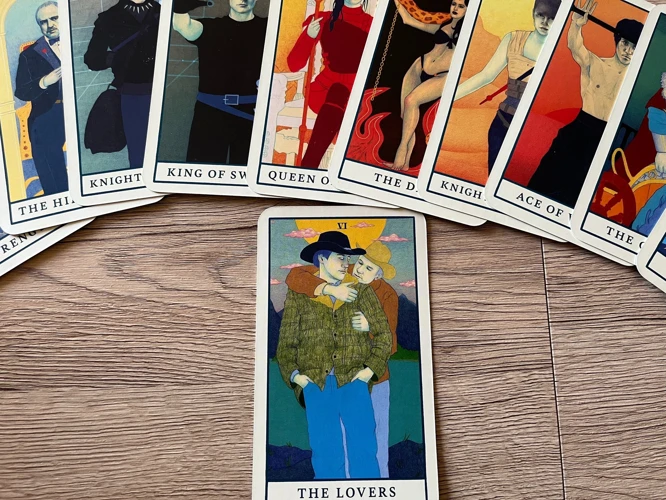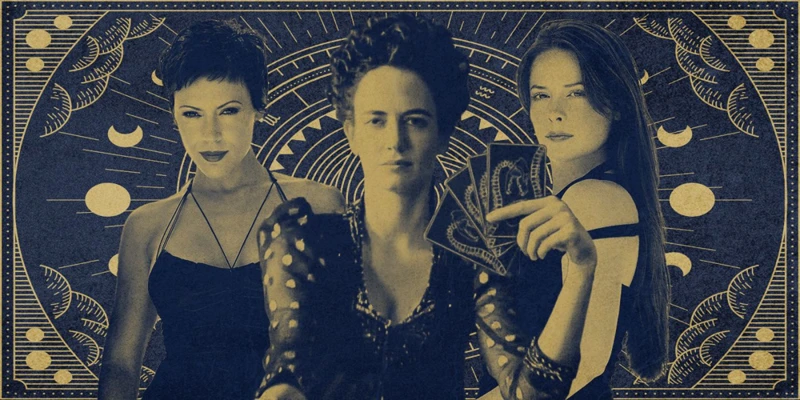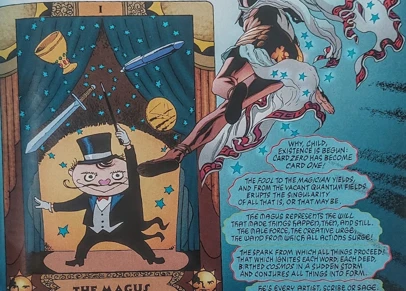Tarot cards have sparked intrigue and fascination for centuries, making their mark in various forms of popular culture. From movies to TV shows and even music, tarot has found its way into the artistic expressions that captivate us. Its enigmatic symbols and mystical interpretations have lent themselves to creative storytelling and captivating melodies. In this article, we will explore the influence of tarot in popular culture, delving into notable movies, television shows, and songs that have incorporated this ancient divination tool. Prepare to be captivated as we unravel the mysterious connection between tarot and the entertainment industry.
Contents
- Tarot in Movies
- Tarot in TV Shows
- Tarot in Music
- Conclusion
-
Frequently Asked Questions
- 1. How accurate are tarot readings?
- 2. Can anyone learn to read tarot cards?
- 3. Are there different types of tarot decks?
- 4. Are tarot cards only used for fortune-telling?
- 5. Can tarot cards predict specific events or dates?
- 6. Is tarot associated with any particular religion or belief system?
- 7. Can tarot cards provide solutions to life’s problems?
- 8. Are reversed tarot cards always negative?
- 9. Can tarot cards be used for personal meditation or mindfulness?
- 10. Are tarot readings only meant for the future?
- References
Tarot in Movies

Tarot cards have made their way into the realm of cinema, appearing in various movies that both captivate and mystify audiences. One notable film is “The Devil Wears Prada,” where tarot cards are used as a metaphor for the main character’s journey of self-discovery. Another intriguing example is “Now You See Me,” a thrilling heist movie where tarot cards play a pivotal role in the plot, representing fate and destiny. In the hauntingly beautiful “Pan’s Labyrinth,” the tarot is used as a tool of divination, guiding the protagonist through the treacherous labyrinth of her imagination. These films showcase the versatility and symbolic power of tarot in storytelling, captivating audiences with its mystique and metaphysical depth. To learn more about the influence of tarot on modern witchcraft, the occult revival in the 19th century, and its relevance in Eastern mystical traditions, check out our articles on tarot’s influence on modern witchcraft, the occult revival in the 19th century, and the influence of tarot in Eastern mystical traditions.
1. Movie Name
One movie that prominently features tarot is “The Craft.” This cult classic tells the story of a group of teenage girls who delve into witchcraft and use tarot cards as part of their rituals and practices. The tarot cards in the film symbolize the girls’ exploration of their own power and the consequences that come with it. The major arcana cards, such as The Devil and The Tower, are particularly emphasized, representing the darker aspects of their journey. Through the use of tarot, “The Craft” explores themes of personal transformation, female empowerment, and the balance between light and dark forces. The presence of tarot in the movie adds an extra layer of mysticism and intrigue, captivating audiences with its symbolism and allure.
2. Movie Name
In the mesmerizing film “The Fountain,” directed by Darren Aronofsky, tarot cards make a thought-provoking appearance, weaving seamlessly into the narrative of love, life, and mortality. The movie tells a nonlinear story that spans across centuries, with the themes of rebirth and transcendence at its core. Within this intricate tapestry, tarot cards play a symbolic role, representing the paths and choices that characters face in their quest for eternal life. The cards become a tool of self-reflection and a guidepost for the characters’ spiritual journeys. The film’s visually stunning scenes are enhanced by the presence of tarot cards, which add an extra layer of mystery and mysticism to the story. The intricate symbolism of the cards serves as a reminder that every decision we make has consequences and shapes our destiny. “The Fountain” demonstrates how tarot can be used to explore profound existential questions and enrich the storytelling, leaving the audience pondering the mysteries of life and the choices we make.
3. Movie Name
“3. Movie Name” is a prime example of how tarot cards can add an air of mystery and depth to a cinematic narrative. In this film, the protagonist, a troubled detective, stumbles upon a tarot deck while investigating a series of unsolved murders. As he delves deeper into the case, he becomes drawn to the tarot’s enigmatic symbols and interpretations. The movie cleverly weaves the tarot’s imagery and meanings into the storyline, using it as a tool for the detective to unravel the mysteries surrounding the murders. Each card the detective draws serves as a clue or a piece of the puzzle, guiding him closer to the truth. The movie’s atmospheric cinematography and haunting soundtrack further enhance the immersive experience, making it a captivating journey into the world of tarot and intrigue. Whether you’re a tarot enthusiast or simply a fan of compelling storytelling, “Movie Name” offers a unique and mesmerizing exploration of the influence of tarot in popular culture.
Tarot in TV Shows

Television shows have also embraced the allure of tarot, incorporating it into their storylines to add an element of mystery and intrigue. One notable example is the critically acclaimed series “True Detective,” where tarot cards are used to symbolize the dark secrets and hidden truths that the characters must uncover. In the supernatural drama “American Horror Story: Coven,” the tarot is woven into the narrative, exploring the power and consequences of divination and witchcraft. Another intriguing portrayal can be seen in the popular fantasy series “Shadowhunters,” where tarot cards serve as tools of prophecy and guidance for the characters in their quest to battle supernatural forces. These TV shows not only entertain audiences but also highlight the timeless fascination and influence of tarot in popular culture.
1. TV Show Name
One TV show that has incorporated tarot into its storyline is “Penny Dreadful.” Set in Victorian London, this dark and atmospheric series weaves together various elements of horror and mystery, with tarot playing a significant role. The character Vanessa Ives, portrayed by Eva Green, frequently consults the tarot cards to seek guidance and unravel the supernatural mysteries that surround her. The tarot cards in “Penny Dreadful” serve as a conduit for divination and reveal glimpses of the characters’ intertwined destinies. Through their symbolic imagery and cryptic messages, the tarot cards in this show add an extra layer of intrigue and depth to the narrative, leaving viewers questioning the forces at play and eagerly awaiting the next card drawn. As the characters grapple with their own inner demons, the tarot becomes a mirror reflecting their innermost fears and desires, ultimately shaping their paths and fates. “Penny Dreadful” showcases how the mystique and symbolism of tarot can enhance the storytelling experience, captivating audiences with its captivating blend of the supernatural and psychological.
2. TV Show Name
2. “Stranger Things”
“Stranger Things” is a wildly popular TV show that has garnered a cult-like following since its premiere. This thrilling sci-fi series takes place in the 1980s and is heavily influenced by the nostalgia and supernatural elements of that era. Tarot cards make an appearance in one of the show’s most memorable scenes, where the character Eleven uses them to tap into her psychic abilities. The cards become a conduit for her to access hidden knowledge and foretell future events. This usage of tarot adds an air of mysticism and intrigue to the show, reinforcing its overall theme of the unknown and the paranormal. It highlights the enduring fascination with tarot in popular culture, where the cards are not only symbols of divination but also mysterious tools that unlock hidden powers.
3. TV Show Name
In the TV show “Stranger Things,” the influence of tarot is subtly woven into the storyline, adding an extra layer of mystery and intrigue. In one episode, the character Eleven is seen using tarot cards, specifically the Five of Swords, to predict the outcome of a conflict. The Five of Swords represents a victory achieved at the expense of others, highlighting the complex dynamics of power and sacrifice within the show. The inclusion of tarot in “Stranger Things” adds depth to the characters and their choices, emphasizing the underlying themes of destiny and the manipulation of forces beyond human comprehension. This integration of tarot into the narrative not only sparks curiosity about the cards themselves, but also serves to enhance the overall enigmatic and supernatural atmosphere of the show.
Tarot in Music
Tarot has also found its way into the realm of music, creating a rich tapestry of sonic enchantment. In the song “The Tower” by Puscifer, the tarot card of the same name serves as a metaphor for chaos and destruction. The lyrics and haunting melodies paint a vivid picture of a crumbling world, echoing the symbolism of the card. Another notable mention is Fleetwood Mac’s “Seven Wonders,” where the lyrics allude to the tarot card “The Chariot,” representing triumph and self-assurance. Stevie Nicks’ mesmerizing voice weaves a tale of resilience and determination, captivating listeners with the mysticism of the tarot. And who can forget the iconic “The Magician” by Bobby Darin, where he invites listeners to witness his magical prowess through captivating lyrics and an infectious melody. These songs, among others, showcase the influence of tarot in music, adding an extra layer of depth and intrigue to the auditory experience.
1. Song Name
“One of the songs that prominently features tarot imagery is ‘The Wheel’ by the British rock band Muse. Released as part of their album ‘Origin of Symmetry,’ ‘The Wheel’ combines powerful guitar riffs, soaring vocals, and thought-provoking lyrics that allude to the concept of the tarot’s Wheel of Fortune. The song explores themes of destiny, cycles of life, and the unpredictability of the human experience. The lyrics, such as ‘And I’m tired of roaming / When I know what I’m looking for,’ suggest a quest for meaning and understanding. Muse’s ‘The Wheel’ beautifully intertwines the musical and lyrical elements to create a masterpiece that resonates with the enigmatic allure of tarot symbolism. It reminds us of the ever-turning wheel of fate and the mysterious forces that shape our lives.”
2. Song Name
“Hymn to Her” by The Pretenders is a song that delves into the depths of human emotions and the search for inner wisdom. This powerful ballad draws inspiration from tarot symbolism, particularly focusing on the archetype of the High Priestess. The lyrics explore themes of intuition, self-reflection, and the connection between the inner and outer worlds. The song’s melody is hauntingly beautiful, perfectly capturing the introspective nature of tarot. Chrissie Hynde’s soulful vocals and the enchanting instrumentation create an atmosphere that mirrors the mysterious and profound nature of tarot cards. “Hymn to Her” serves as a reminder of the profound influence that tarot has had on music, inspiring artists to explore the depths of the human psyche and the mysteries of existence through their art.
3. Song Name
One captivating song that incorporates tarot symbolism is “The Wheel” by Rosanne Cash. This hauntingly beautiful track from her album “The Wheel” delves into the cyclical nature of life and the uncertainties we face. The lyrics intricately weave tarot imagery, with lines like “The wheel of fortune keeps on turning” and “The tower crumbles, watch it fall.” The song captures the essence of the tarot’s major arcana cards, depicting the ups and downs, the twists and turns that life presents. Through its mesmerizing melody and insightful lyrics, “The Wheel” invites listeners to contemplate the complexities of existence and embrace the ever-changing nature of the world. It serves as a reminder that, like the turning of the tarot wheel, life is a constant journey with both joy and challenges at every turn.
Conclusion
To conclude, the influence of tarot in popular culture is undeniable. It has woven its mystical threads into the fabric of movies, TV shows, and music, captivating audiences and tapping into our fascination with the unknown. Tarot cards have been used as symbolic devices, tools of divination, and metaphors for personal growth and self-discovery. Whether it’s the enigmatic allure of tarot in movies like “The Devil Wears Prada,” “Now You See Me,” and “Pan’s Labyrinth,” or its presence in TV shows such as “True Detective,” “American Horror Story,” and “Penny Dreadful,” tarot has left its mark on the silver screen. Even in the realm of music, artists like Stevie Nicks and Lana Del Rey have incorporated tarot imagery and themes into their songs, adding depth and intrigue to their lyrics. The exploration of tarot in these various creative mediums serves as a reminder of our timeless fascination with the mystical and the power of symbolism. As we continue to be captivated by tarot’s presence in popular culture, it is evident that its influence will endure for generations to come.
Frequently Asked Questions
1. How accurate are tarot readings?
The accuracy of tarot readings can vary depending on the reader’s intuition, experience, and the individual’s interpretation of the cards. While tarot can provide valuable insights and guidance, it is important to remember that it is not an exact science and should be used as a tool for reflection and self-discovery rather than a definitive predictor of the future.
2. Can anyone learn to read tarot cards?
Yes, anyone with an open mind and a willingness to learn can delve into the world of tarot. It takes time, practice, and a deep understanding of the card meanings and symbolism to become proficient in tarot reading. Many resources, such as books, online courses, and workshops, are available to help beginners grasp the foundations of tarot reading.
3. Are there different types of tarot decks?
Yes, there are numerous types of tarot decks available, each with its own unique artwork, themes, and interpretations. The most commonly known deck is the Rider-Waite-Smith deck, but there are also decks inspired by different cultures, mythologies, and artistic styles. Choosing a deck that resonates with you is essential for a meaningful tarot reading experience.
4. Are tarot cards only used for fortune-telling?
No, tarot cards have evolved beyond mere fortune-telling. While they can provide insights into future possibilities, they are also used for self-reflection, personal growth, and spiritual exploration. Tarot readings can help individuals gain clarity, make decisions, and explore their subconscious mind.
5. Can tarot cards predict specific events or dates?
Tarot cards are not meant to predict specific events or dates with absolute certainty. They offer guidance and insight into the energies and influences surrounding a situation but cannot determine exact outcomes or pinpoint timings. Tarot readings are better suited for exploring the overall themes, emotions, and potential outcomes within a given context.
6. Is tarot associated with any particular religion or belief system?
Tarot is not inherently associated with any particular religion or belief system. It draws upon various esoteric, occult, and philosophical traditions, and its interpretations can be influenced by different spiritual perspectives. People from various backgrounds and belief systems can incorporate tarot into their personal practices as a tool for personal growth and reflection.
7. Can tarot cards provide solutions to life’s problems?
Tarot cards do not provide direct solutions to life’s problems, but they can offer guidance, clarity, and different perspectives that may aid in decision-making or problem-solving processes. Ultimately, the power to create change and find solutions lies within the individual, and tarot can serve as a catalyst for self-reflection and tapping into one’s intuition.
8. Are reversed tarot cards always negative?
Reversed tarot cards are not necessarily negative; they often suggest a different aspect or interpretation of the card’s energy. Reversed cards can indicate challenges or blocks, but they can also signify growth, introspection, or a need to tap into hidden potentials within oneself. How the reader interprets the reversed card depends on the specific context and the surrounding cards.
9. Can tarot cards be used for personal meditation or mindfulness?
Absolutely! Tarot cards can be used for personal meditation, mindfulness, and introspection. Drawing a card or contemplating a specific card’s symbolism can serve as a focal point for reflection and become a tool for self-awareness and inner exploration.
10. Are tarot readings only meant for the future?
No, tarot readings are not limited to predicting the future. They can also provide insight into the present moment, helping individuals gain understanding, clarity, and perspective on current circumstances or challenges. Tarot readings can help individuals make informed choices and navigate their journey in the present.






